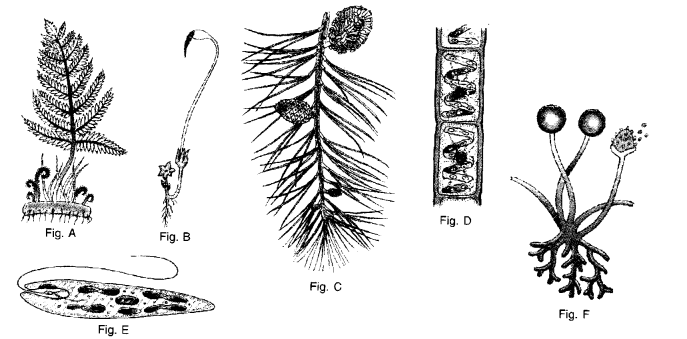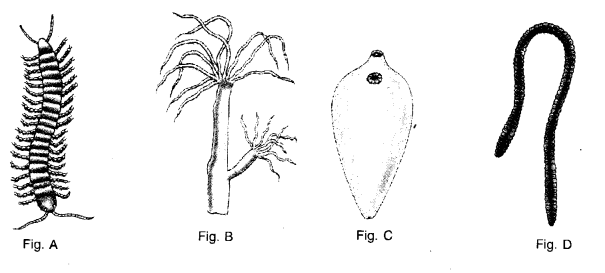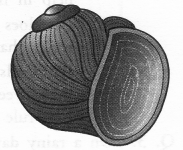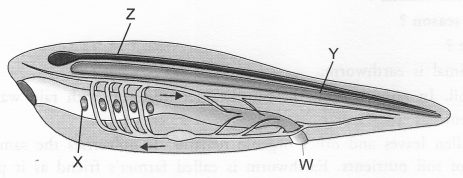HOTS Questions for Class 9 Science Chapter 7 Diversity in Living Organisms
These Solutions are part of HOTS Questions for Class 9 Science. Here we have given HOTS Questions for Class 9 Science Chapter 7 Diversity in Living Organisms
Question 1.
(a) Identify figures A to F.

(b) Which one of them is unicellular and eukaryotic organism ?
(c) Which one of them shows
- Heterotrophic nutrition
- Mixotrophic nutrition ?
(d) Which one of them is non-vascular embryophyte ?
(e) In which of them, xylem lacks vessels while phloem is devoid of companion cells ?
(f) In which of them endosperm is halpoid ?
(g) Which of them is commonly called
- Bread Mould
- Male Shield Fern ?
Answer:
(a) Identification.
A-Fern (Male Shield Fern, Dryopteris)
B-Moss (Funaria).
C—Pinus.
D—Spirogyra.
E—Euglena.
F-Rhizopus.
(b) Unicellular Eukaryotic Organism. Euglena.
(c)
- Heterotrophic Nutrition. Rhizopus.
- Mixotrophic Nutrition. Euglena.
(d) Non-vascular Embryophyte. Moss (Funaria)
(e) Xylem without Vessels and Phloem without Companion Cells. Pinus.
(f) Haploid Endosperm. Pinus
(g)
- Bread Mould._Rhizopus.
- Male Shield Fern. Dryopteris.
More Resources
- HOTS Questions for Class 9 Science
- NCERT Solutions for Class 9 Science
- Value Based Questions in Science for Class 9
- NCERT Exemplar Solutions for Class 9 Science
- Previous Year Question Papers for CBSE Class 9 Science
Question 2.
(a) Identify figure A to D.

(b) Which one belongs to
- Platyhelminthes
- Arthropoda
- Annelida ?
(c) Which one of them has
- Tissue level organisation
- Primitive organ level organisation ?
(d) Which one of them has
- Flame cells as exretory organs
- Nephridia as excretory organs ?
(e) Which one of them has poison claw ?
(f) Which one of them is
- Diploblastic
- Triploblastic ?
Answer:
(a) Identification.
A-Centipede.
B-Hydra.
C-Liverfluke {Fasciola).
D- Earthworm {Pheretima posthuma).
(b)
- Plathyhelminthes—Liverfluke (Fasciola)
- Arthropoda-Centipede (Scolopendra).
- Annelida-Earthworm {Pheretima posthuma).
(c)
- Tissue Level Organisation. Hydra.
- Primitive Organ Level Organisation. Liverfluke (Fasciola)
(d)
- Flame Cells. Liverfluke (Fasciola)
- Nephridia. Earthworm {Pheretima posthuma)
(e) Poison Claw. Centipede {Scolopendra)
(f)
- Diploblastic. Hydra.
- Triploblastic. Liverfluke {Fasciola), Centipede (Scolopendra), Earthworm {Pheretima posthuma).
Question 3.
(a) Identify the figure and write down the phylum to which it belongs.
(b) Which type of

- Locomotory organ is present in it.
Circulatory system is present in it.
(c) Which type of symmetry is present ?
Answer:
(a) Identification. Pila (Apple Snail). Phylum. Mollusca.
(b)
- Locomotory Organ. Foot,
- Circulatory System. Open (Haemocoel).
(c) Symmetry. Asymmetry due to torsion (spirally coiled).
Question 4.
(a) Label W, X, Y and Z.

(b) Identify the above diagram.
(c) Name the phylum in which notochord is present.
(d) Name the subphylum in which notochord is present throughout life.
Answer:
(a) W-Anus.
X-Gill slits.
Y-Notochord.
Z-Nerve cord.
(b) Identification. Basic characteristics of chordates.
(c) Phylum with Notochord. Chordata.
(d) Subphylum with Notochord throughout Life. Cephalochordata.
Hope given HOTS Questions for Class 9 Science Chapter 7 Diversity in Living Organisms are helpful to complete your science homework.
If you have any doubts, please comment below. Learn Insta try to provide online science tutoring for you.